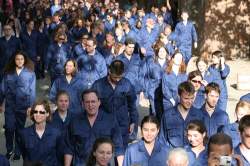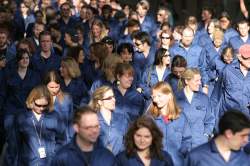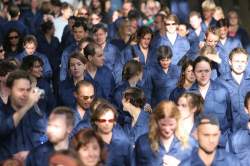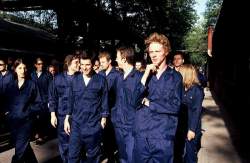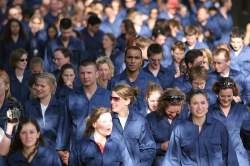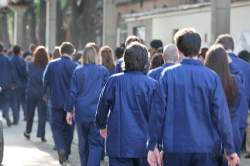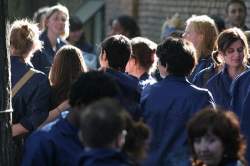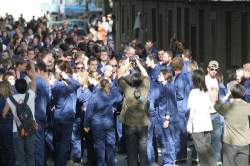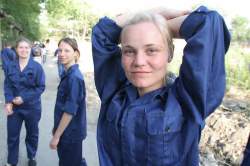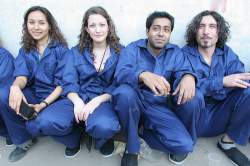The Short Step
1 May 2005, Dashanzi Art District, Beijing
The Short Step took place in Beijing on 1 May 2005. 400 foreigners came to Dashanzi, changed into traditional Chinese blue factory worker suits, and walked through the 798 factory district. We gathered near the main gate for the photograph displayed above, and then went back. That was the event. Obviously it is about change in China, and the relationship with the west.
That The Short Step happened at all — and with no special police authorisation — is not without significance. As little as a few years ago it would have been inconceivable. It is to my knowledge the first piece of large-scale political performance art to take place here in China.
Earlier that day I’d spoken to a thinly veiled Chinese spy, who was asking me what exactly I was doing. ‘No no,' I said, ‘nothing political … just some friends getting together for a photo … yes I was going to give out some free shoes, as souvenirs ….' I’d just taken another call from a Canadian woman, asking anxiously if it was still possible to join the Great Blue March for World Peace that afternoon. The spy had said he’d come along to check it out. Just then the phone rang again. ‘Hey man,' the voice said, ‘where do I have to go to pick up my free Mao suit?' Everyone I spoke to seemed to be building a different interpretation …
For me the idea was always very simple: to take a well-known received image of China, and recreate it using non-Chinese people. I was thinking about the way in which ideas about cultures are generated.
Change here is happening so fast there is barely time to reflect upon its implications. Western influences are pouring in, a new mainstream is being created, and with the current rate of economic growth China is set to outsize the rest of the world. As more and more manufacturing jobs move to China and more of the most recognised western products are exported hence, it becomes increasingly unclear who is subsuming who. Who is in which country’s trousers? The route we took retraces that of the thousands of Chinese workers who have lived in the 798 district over the last fifty years, wearing these blue suits, and working in the 798 factories. We chose the number of foreigners — 400 — in response to a couple of “change” statistics: a proposal by the Chinese government to build 400 new cities between now and 2020; and the anticipated 400 million rural migrants who would be urbanising over that period. These numbers are astonishing. Most migrants will go to work in factories or on construction sites, again in exactly these blue worker suits. Most of the people reading this are probably university educated, and wearing cheap shoes made in China.
One interesting point about the photos is how beautiful people say they are. I think they’re beautiful too — the light was clean that day, and the colours strong. Yet nobody ever says this about the photos from rallies celebrating the Great Leap Forward or the Cultural Revolution, also taken in 798. The images in composition are very much the same — the same numbers of people, the same location, the very same suits. Why does it feel so different when the people are not Chinese?
It seems that volumes of Chinese faces in blue worker suits have become an accepted received concept; loaded with notions of numericity, loss of individuality, otherness …. A large group of people all dressed the same are somehow seen as all being the same, as having little identity as individuals, and together making a rough number. They are a more or less so many, and may be moved around, accommodated, put to work — it’s something that as consumers we are all involved in. A new great leap forward is occurring, and with it a new cultural revolution — both off the back of China’s extraordinary new manufacturing power. Literally in the middle of this, in a former communist factory, I wanted to ask if it would feel the same were the people non-Chinese. Do they also lose identity as you look at the photos? Are there still individuals? How does an individual relate to a cultural identity, and is a culture specific to its individuals?
There is something about the way in which we try to separate ideas about history and images and nations from other larger-scale ideas about humanity. It seems that there is a gap in the thinking here, in which The Short Step sits, and feels uncanny.
Could one nation’s history ever have happened to another group of people? Would one nation’s future ever be acceptable to another nation’s citizens?
Adrian Hornsby, Jeremy Mercer, Quinn Comendant
Photography by Ben McMillan and Nick May
